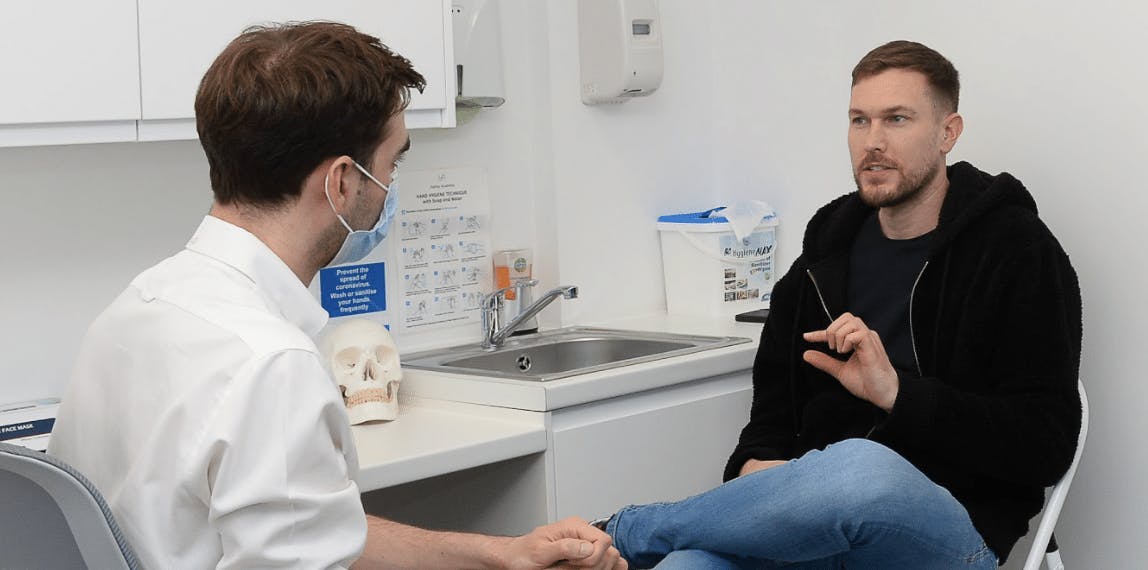Aesthetics Marketing: Plan Your Patient Experience

In the fourth instalment of our 10 Tips for Marketing Your Aesthetics Practice series, we’re giving you a few pointers on how to plan your patient experience.
Creating the ultimate environment for your patient’s treatment and planning your communications around this effectively can provide the best aesthetics marketing of all: word of mouth referrals.
Let’s get started – and don’t forget you can save this article for future reference over on the Harley Academy Instagram account!
Think about the type of experience you enjoy as a customer or patient

Another great piece of advice we picked up from top aesthetics consultant, Vanessa Bird, who we mentioned in the treatment menu planning part of this series, involves how to plan your patient experience.
In order to offer the best possible patient experience, you need to go through every step of the process yourself. Put yourself in the shoes of the patient, from booking to the second they arrive at your practice, through to when they leave and how they are followed up with.
Vanessa Bird advises practitioners setting up a new aesthetics clinic or their own room within another practice to reflect on their own experiences.
Think about what customer care experiences you have enjoyed. These don’t have to be in aesthetics clinics, they could be at a hotel or restaurant, a spa or hair salon. Anywhere you’ve received good service or noticed nice little touches that made you feel good – these are the elements you want to incorporate into your offering.
This can range from having a beautifully – but gently – fragranced space and fluffy towels, to being sent precise driving and parking instructions.
Additionally, once you have a map of what you want your patient experience to look like, revisit your Ideal Patient avatars. Would your plans appeal to your ideal clients? Review every step through their eyes to be sure you’re on the right track.
Let’s take a look at some examples of what to consider at each stage of the patient journey...
The client contacts you to book an appointment

- How do they contact you?
- How long do they wait for a response?
- How do you answer the phone?
- How do you respond to their email?
- How do you reply if you receive a voicemail?
Consider each aspect of this carefully. Think about the following key aspects when deciding on your official appointment booking protocols. Although it may just be you doing this for now, if you plan properly and refine this into an official, written process, you can pass it on to the staff you may hire in the future!
- Do I set a professional and reliable but friendly tone?
- Am I representing my business in its best light?
- Will my patients be impressed by my approach?
- What can I do to be as helpful as possible and make my patient’s life easier?
- How would my Ideal Patients like to interact in each scenario and would they respond well to my current plans?
It is worth noting here, for planning the communication aspect of your patient experience, that if a patient calls you or has contacted you via email and provides a mobile phone number, do not assume that it is okay to contact them via text or a messaging app such as WhatsApp.
If they have not specifically asked that you contact them in this way, stick to calling them or emailing them (or both!), then ask them about their preferred communication methods. Always ask permission before using their phone number for anything else, such as texting or using a third party messaging app.
Another simple top tip here, which can really make a huge difference when speaking to patients, is this: smile when you answer the phone. Your patients will be able to hear it in your voice and it will help you to come across in a warm, approachable manner.
Your client has booked an appointment for next week

Do you remind them of their appointment?
- If so, how?
- What information do you give them before they arrive?
- Are you pet friendly? If you work from a room within another business and that business allows pets but you do not – obviously! – let your patient know that their dog is welcome but would have to wait at reception. That way they can make the decision as to whether they are comfortable with this or not.
- Find out your patient’s preferred methods of communication and make sure they have everything they need in terms of information. This includes what they should and shouldn’t do before their appointment, how to find you, what to do if they’re running late or need to reschedule, the downtime associated with the treatment, remind them about wearing a mask, etc.
On the day of their appointment, what will your patient find when they arrive?

- Is there parking available nearby?
- Are there any parking issues or restrictions that day – roadworks, for example, that the patient may not be expecting?
- What does the outside of your practice look like?
- Do you have a waiting room?
- Is there somewhere your patient can leave their coat and/or bag?
- Who will greet your patient?
- Do you have drinks available?
- Have you checked the bathroom since the last patient?
Do your best to ensure your patient’s visit goes smoothly and is as stress-free as possible. Upsets like unexpected roadworks, meaning the parking information you provided is no longer accurate, or encountering a bathroom that needs cleaning is a surefire way to get your appointment off to a bad start.
Conversely, being prepared for every likely eventuality – for example, having a multi-phone charger available that can charge both iPhones and Android models is always a winner – coupled with a “nothing is too much trouble” attitude should get things off swimmingly!
For a slick, professional and pleasant experience all round, set the tone for the appointment by making sure you and your environment are as welcoming as possible. This brings us on to the next point...
Your patient is now with you for a consultation and potentially a treatment, too

- What does your room look like?
- What does your room smell like?
- Are you playing music? If so, what kind? And at what volume?
- Is hand sanitizer easily accessible?
- What aftercare advice do you have for them and how do you provide it?
Again, refer back to your Ideal Patient avatars and experiences you have enjoyed elsewhere to determine how to create the right ambiance for your practice. This can have a huge effect on your patient’s first impressions of your service so get the tone right from the offset and, should you decide to play music – either your own or your patient’s choice – always ask if the volume is okay for them.
When it comes to aftercare, you can really distinguish yourself here by going the extra mile. Make sure your patient knows how to contact you – not just the clinic – for any queries or, especially, in case of emergency. Providing verbal information at the appointment is obviously necessary but be sure to follow up with written information either via email, by giving them printed information to take home with them, or both.
After the patient’s appointment, when and how will you follow up with them?

- Will you check in to see how they’re doing the following day or week, for example?
- When and how do you book their review appointment?
- What if they don’t want to come for a review?
- Do you have a mailing list you’d like to sign them up to? They will need to consent to this.
- Will you ask them to leave you a review or give you feedback on your services?
- If so, where do they do that and how? If it’s too complicated, they won’t do it!
- Do you want to share their before and after treatment images on your social media or website? If so, you will need their express written permission for this – how will you go about getting this? Do you have a simple form they could complete? Do they consent to having their name and/or age used? Do they want to be tagged and, if so, what are their social media usernames? Again, you’ll need all this confirmed in writing.
These are just a few of the many, many scenarios to consider when you plan your patient experience. As you grow your patient list, you’ll get to understand more about what your patients appreciate – what works and what doesn’t – and can amend your processes as your practice evolves.
The old adage of “treat others as you would like to be treated” should be your mantra, here.
In addition to being a fully qualified professional in medical aesthetics with a Level 7 Diploma in Botox and Dermal Fillers, your next biggest selling point is your customer experience. Work hard at this and you’ll find it not only becomes second nature very quickly, but it will also reap rewards in terms of word-of-mouth referrals. And who doesn’t want this kind of effective, free marketing…?
All information correct at the time of publication. Article last fact-checked: 20 March 2023
Download our full prospectus
Browse all our injectables, dermal fillers and cosmetic dermatology courses in one document
By submitting this form, you agree to receive marketing about our products, events, promotions and exclusive content. Consent is not a condition of purchase, and no purchase is necessary. Message frequency varies. View our Privacy Policy and Terms & Conditions
Attend our FREE open evening
If you're not sure which course is right for you, let us help
Join us online or in-person at our free open evening to learn more
Our Partners













STAY INFORMED
Sign up to receive industry news, careers advice, special offers and information on Harley Academy courses and services

